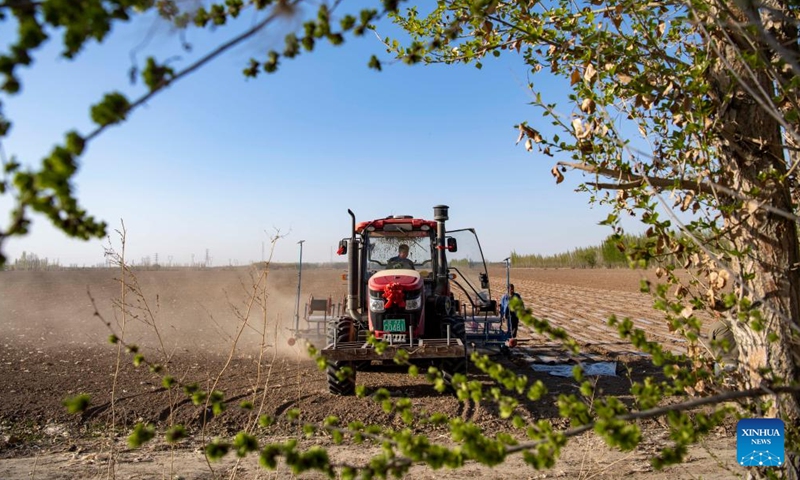Xinjiang plans record fixed-asset investment in 2022, focusing on key infrastructure projects

Workers operate a seeder in Ili Mehmet's cotton field in Shawan, northwest China's Xinjiang Uygur Autonomous Region, April 16, 2022. Ili Mehmet, 50, lives in Shawan, a major cotton-producing area in Xinjiang.Photo:Xinhua
The planned fixed-asset investment in Northwest China's Xinjiang Uygur Autonomous Region will hit a new high of 900 billion yuan ($135.09 billion) this year, with focuses on key projects in basic infrastructure as well as strategic emerging industries such as silicon substrate, basic infrastructure, power grid and new energy industrial bases, making investment play a pivotal role in driving its overall growth, the local economic planner announced.
Xinjiang has a vast land but there is a gap in basic infrastructure. The local government will prioritize basic infrastructure construction in transportation, energy, hydraulic engineering, telecommunication and urbanization, according to the local reform and development commission.
For example, it will facilitate a railway linking Hotan with Ruoqiang county, and construction of a railway linking Yining county with Aksu Prefecture will begin soon.
Also, the region will tap into its potential to develop the new energy industry. Based on a guideline issued earlier this year, Xinjiang has identified seven major projects to build itself into a base for wind and photovoltaic power, and it will encourage investment entities to make full use of the desert and wilderness to construct new energy projects.
It will also encourage electricity consumption industries to elevate the usage ratio of renewable energy resources, and guide newly invested projects to accommodate new energy projects so as to substitute its energy consumed with green electricity, according to the local authorities.
In 2021, the overall fixed-asset investment in Xinjiang reached 820 billion yuan, up 15 percent year-on-year, the Xinhua News Agency reported.
Industry observers said that Xinjiang's fixed-asset investment plan, which is in line with national strategy, will not only create job opportunities and convenient tourism and transportation networks but also drive regional growth.
In the first quarter, Xinjiang's GDP grew 7 percent year-on-year, 2.2 percentage points higher than the national average.
Xinjiang has also set up communication mechanisms with government departments and centrally administrated state-owned enterprises (SOEs). According to the local authorities, a total of 14 centrally administrated SOEs have signed contracts with the local bureau, with a total investment of 611.7 billion yuan.
China in recent months has accelerated fixed-asset investment as parts of ongoing efforts to shore up virus-hit economy. A number of cities have unveiled fixed-investment plans to date. For example, Shenzhen in South China's Guangdong plans basic infrastructure investment of 220 billion yuan and new infrastructure investment of 100 billion yuan.
In the first four months of this year, China's fixed-investment grew 6.8 percent to 15.35 trillion yuan.
Global Times



